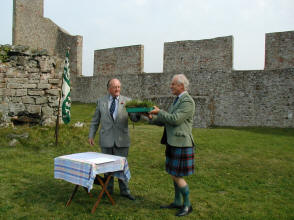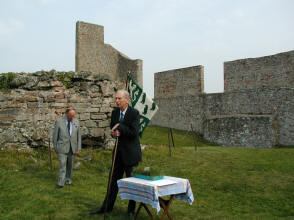|
A ‘Stane & Turf’ ceremony took place at Hume Castle on
Wednesday (August 31st ) to mark the historic handing over of
the castle by the Berwickshire Civic Society to the Clan Home Association,
being the traditional form marking new ownership of important property.
Hume Castle is significant in being a very rare example
of a square-walled fortification in Southern Scotland, dating from the
early 1200’s; unusually, it was not destroyed by Robert the Bruce after
its capture. After Roxburgh, it was the most important of the castles on
the Scottish side of the Border during the Middle Ages, sited in a
commanding position dominating the Merse and visible from many parts of
Berwickshire and Roxburghshire. James II and his queen stayed there
during the siege of Roxburgh in 1460, during which he lost his life.
Strengthened in 1515, it was taken by the English in 1547, recaptured by
Lord Home in 1549 and ransacked again by the English in 1569. The family
had moved to the Hirsel before it suffered a devastating bombardment by
Cromwell’s forces in 1651,which left it in ruins. Following the
acquisition of the barony of Home from the earl of Home, by Hugh Hume,
earl of Marchmont, in 1766, the outer walls were built up on the remains
of the original in 1789, to give us the edifice we see today, designed to
be clearly visible from Marchmont House.
Lord Marchmont’s descendants eventually sold the Hume
estate at the beginning of the 20th century and it was
thereafter acquired by the State for division into smallholdings in 1929,
the castle eventually passing into the care of the Berwickshire Civic
Society in 1995 following its restoration. The Clan Association is
particularly grateful to the Civic Society for this opportunity of
bringing the castle back into possession of the Homes again after a gap of
a hundred years. The Association has formed a charitable trust, the Hume
Castle Preservation Trust, which will take on the responsibility of its
care, supported by Historic Scotland.
Humes all over the world look to the castle for their
origins; It was Patrick of Greenlaw’s son, William, who first took the
designation of Home, following his marriage to his cousin and
proprietorix of the Home estate, Ada, in about 1220. Eventually Home
became the dominant name in Berwickshire and the East March of the
Scottish Border. It is derived from the Old English word Hôm, meaning
‘at the heights’ , a fair description of the rocky outcrop on which the
castle sits. It has always been pronounced Hume, and in the past many
families changed the spelling from o to u to avoid mis-pronounciation by
people outwith the Borders.
Present at the ceremony was the Lord Lieutenant of
Berwickshire, Major Alexander Trotter and the convener of the Scottish
Borders Council, councillor Alasdair Hutton. Representing the Berwickshire
Civic Society was its president, Major General Sir John Swinton, who was
instrumental in securing the funding for the restoration of the castle
twenty five years ago and taking the castle into the care of the society
in 1995, and Colonel Simon Furness, who, as chairman, handed over the
property to the Clan Home Association, represented by its president and
the chief of Clan Home, the Earl of Home, the association’s convener and
chairman of the Hume Castle Preservation Trust, Dr Ian Maitland Hume,
together with Lord Home’s son, Lord Dunglass, members of the civic
society, the clan association and residents of the village of Hume.
For further information contact: Ian Maitland Hume
+441361 810321 or +447980 242530 or email:
ianmhume@tiscali.co.uk (Convener, Clan Home Association)


Col Furness handing over turf & stane to Dr
Hume and on right Lord Home addresses gathering |
